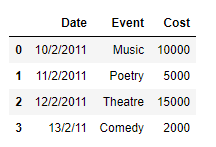Create a list from rows in Pandas DataFrame | Set 2 (original) (raw)
Last Updated : 29 Jan, 2019
In an earlier post, we had discussed some approaches to extract the rows of the dataframe as a Python's list. In this post, we will see some more methods to achieve that goal.Note : For link to the CSV file used in the code, click here.Solution #1: In order to access the data of each row of the Pandas dataframe, we can use DataFrame.iloc attribute and then we can append the data of each row to the end of the list.
Python3 1== `
importing pandas as pd
import pandas as pd
Create the dataframe
df = pd.DataFrame({'Date':['10/2/2011', '11/2/2011', '12/2/2011', '13/2/11'], 'Event':['Music', 'Poetry', 'Theatre', 'Comedy'], 'Cost':[10000, 5000, 15000, 2000]})
Print the dataframe
print(df)
`
Output :  Now we will use the
Now we will use the DataFrame.iloc attribute to access the values of each row in the dataframe and then we will construct a list out of it.
Python3 `
Create an empty list
Row_list =[]
Iterate over each row
for i in range((df.shape[0])):
# Using iloc to access the values of
# the current row denoted by "i"
Row_list.append(list(df.iloc[i, :]))Print the list
print(Row_list)
`
Output :  As we can see in the output, we have successfully extracted each row of the given dataframe into a list. Just like any other Python's list we can perform any list operation on the extracted list.
As we can see in the output, we have successfully extracted each row of the given dataframe into a list. Just like any other Python's list we can perform any list operation on the extracted list.
Python3 `
Find the length of the newly
created list
print(len(Row_list))
Print the first 3 elements
print(Row_list[:3])
`
Output : 
 Solution #2: In order to access the data of each row of the Pandas dataframe we can use
Solution #2: In order to access the data of each row of the Pandas dataframe we can use DataFrame.iat attribute and then we can append the data of each row to the end of the list.
Python3 1== `
importing pandas as pd
import pandas as pd
Create the dataframe
df = pd.DataFrame({'Date':['10/2/2011', '11/2/2011', '12/2/2011', '13/2/11'], 'Event':['Music', 'Poetry', 'Theatre', 'Comedy'], 'Cost':[10000, 5000, 15000, 2000]})
Create an empty list
Row_list =[]
Iterate over each row
for i in range((df.shape[0])): # Create a list to store the data # of the current row cur_row =[]
# iterate over all the columns
for j in range(df.shape[1]):
# append the data of each
# column to the list
cur_row.append(df.iat[i, j])
# append the current row to the list
Row_list.append(cur_row)Print the list
print(Row_list)
`
Output : 
Python3 `
Find the length of the newly
created list
print(len(Row_list))
Print the first 3 elements
print(Row_list[:3])
`
Output : 
